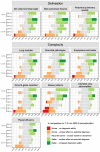Optimization of the Reconstruction Settings for Low-Dose Ultra-High-Resolution Photon-Counting Detector CT of the Lungs
- PMID: 38066763
- PMCID: PMC10706225
- DOI: 10.3390/diagnostics13233522
Optimization of the Reconstruction Settings for Low-Dose Ultra-High-Resolution Photon-Counting Detector CT of the Lungs
Abstract
Photon-counting detector computed tomography (PCD-CT) yields improved spatial resolution. The combined use of PCD-CT and a modern iterative reconstruction method, known as quantum iterative reconstruction (QIR), has the potential to significantly improve the quality of lung CT images. In this study, we aimed to analyze the impacts of different slice thicknesses and QIR levels on low-dose ultra-high-resolution (UHR) PCD-CT imaging of the lungs. Our study included 51 patients with different lung diseases who underwent unenhanced UHR-PCD-CT scans. Images were reconstructed using three different slice thicknesses (0.2, 0.4, and 1.0 mm) and three QIR levels (2-4). Noise levels were determined in all reconstructions. Three raters evaluated the delineation of anatomical structures and conspicuity of various pulmonary pathologies in the images compared to the clinical reference reconstruction (1.0 mm, QIR-3). The highest QIR level (QIR-4) yielded the best image quality. Reducing the slice thickness to 0.4 mm improved the delineation and conspicuity of pathologies. The 0.2 mm reconstructions exhibited lower image quality due to high image noise. In conclusion, the optimal reconstruction protocol for low-dose UHR-PCD-CT of the lungs includes a slice thickness of 0.4 mm, with the highest QIR level. This optimized protocol might improve the diagnostic accuracy and confidence of lung imaging.
Keywords: lung; photon-counting detector CT; quantum iterative reconstruction; slice thickness; ultra-high resolution.
Conflict of interest statement
D.G. and R.K. received speaking fees from Siemens Healthineers. T.E. reports an advisory board membership of Siemens Healthineers and has received speaking fees and travel reimbursement from Siemens Healthineers. D.G., M.C.H., T.E., Y.Y., C.D., L.M. and T.J. receive institutional research support from Siemens Healthineers.
Figures




References
-
- Larici A.R., Cicchetti G., Marano R., Merlino B., Elia L., Calandriello L., del Ciello A., Farchione A., Savino G., Infante A., et al. Multimodality Imaging of COVID-19 Pneumonia: From Diagnosis to Follow-up. A Comprehensive Review. Eur. J. Radiol. 2020;131:109217. doi: 10.1016/j.ejrad.2020.109217. - DOI - PMC - PubMed
-
- Ruaro B., Baratella E., Confalonieri P., Confalonieri M., Vassallo F.G., Wade B., Geri P., Pozzan R., Caforio G., Marrocchio C., et al. High-Resolution Computed Tomography and Lung Ultrasound in Patients with Systemic Sclerosis: Which One to Choose? Diagnostics. 2021;11:2293. doi: 10.3390/diagnostics11122293. - DOI - PMC - PubMed
-
- Ruaro B., Baratella E., Confalonieri P., Wade B., Marrocchio C., Geri P., Busca A., Pozzan R., Andrisano A.G., Cova M.A., et al. High-Resolution Computed Tomography: Lights and Shadows in Improving Care for SSc-ILD Patients. Diagnostics. 2021;11:1960. doi: 10.3390/diagnostics11111960. - DOI - PMC - PubMed
LinkOut - more resources
Full Text Sources

